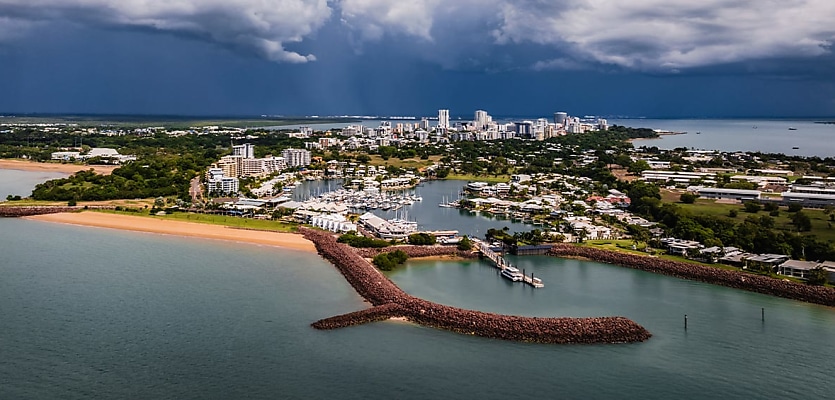The national residential property market has been valued near $12 trillion, driven by lower borrowing costs, tight supply, and strong investment activity, with Darwin leading the growth.
The total value of Australia’s residential property market has reached $11.8 trillion for the first time, increasing by $678 billion over the past year, according to Cotality data.
Since the first interest rate cut in February, the property markets across the country have reacted strongly to lower borrowing costs and tight supply, with Darwin leading the way for capital growth.
Cotality’s Monthly Housing Chart Pack for October showed that national dwelling values have risen 2.2 per cent over the three months to September.
The price surge marked the largest quarterly increase since the three months to May 2024, which also saw a growth of 2.2 per cent.
The data showed growth rising for the fourth consecutive month, climbing from 3.7 per cent in 2024-25 to 4.8 per cent in the year ending September.
Cotality’s head of research Eliza Owen said the price growth milestone showed market resilience, though uncertainty remained over further cash rate cuts and inflation’s impact on momentum.
“However, if the property market were to continue at its current rate of growth, it’s possible the combined market value could hit $12 trillion by the end of the year,” she said.
In particular, the data showed that areas such as Wanguri and Durack in the Northern Territory experienced a growth of 20.1 per cent during the period between February and September.
According to Cotality, the surge in Darwin was a reflection of the blend of relative affordability, low levels of housing supply, and a notable lift in investment activity.
Smart Real Estate director Stewie Martin said that Darwin had seen a lot of growth in the past year, particularly in the northern suburbs and the greater Palmerston region.
“We've experienced at least 30 per cent growth in the last 12 months, particularly with free freestanding houses, but the unit and townhouse sector is kind of rapidly starting to get moving in the last couple of months,” he told REB.
In addition, the number of days on market has been reduced due to market strength, but agents have still been dealing with heavy workloads because of increased volume.
Further, Martin said there was plenty of upside for investors, with median prices hovering around $650,000 to $700,000; much lower than other capital cities.
“In Australia, we have the highest rental yields as well. Obviously, for agents after almost a decade of a pretty subdued market, we're now experiencing much higher volume.”
Owen said that the data highlighted a broad trend of Darwin leading Australia’s capital growth, with city home values up 13.4 per cent year-to-date.
“It’s a relatively affordable market, and investors may be taking note of high yields and rapid value increases.”
In the 12 months to September, Brisbane’s dwelling values rose by 8.8 per cent, with Perth seeing a 7.5 per cent increase in dwelling values, while Adelaide’s dwelling values rose 6.2 per cent over the year.
Despite 3.0 per cent growth in Sydney and 1.9 per cent in Melbourne, most suburbs, especially inner-city, lifestyle, and high-density unit areas, have seen values decline since February.
In Sydney, Milsons Point saw a -7.1 per cent fall in property values, while Kirribilli followed with a -6.3 per cent drop, the steepest declines across capital cities.
According to Holmes St. Clair Crows Nest partner, Chris Bell, Sydney has been experiencing ‘erratic results’ across the board, but the inconsistency is expected within the current economy.
“For every questionable result, there's another that sells pre-auction with strong overall interest and underbidders.”
Bell said that lately, home buyers have been more cautious and less likely to progress with purchases despite the availability of extended settlements and bridging options.
He said that agents must dedicate more time to having informative and transparent conversations to see deals through, instead of relying on superficial interest from buyers.
“Experienced agents have been balancing this with more strategic and broader reach in property marketing, but clearly not all.”
Despite the data showing a decline in property values in Milsons Point, Bell noted that inconsistencies across sold properties make it very difficult to monitor on a chart.
The two-bedroom market ranges from around $1.8M to the early $4M's, with three-bedroom units ranging from mid $2M's to at least $8M.
“The individual properties that have transacted really need to be benchmarked against recent comparables in their block, while factoring in things such as proposed remedial works and upgrades to assess reliably.”
“We recently achieved one of the highest ever residential prices on a sale in Milsons Point, so people are still prepared to pay a premium for the right property.”
Owen said that some of the top-performing regional markets were also the most affordable, with the dwelling markets in Boggabri in regional NSW, and Rochester in regional Victoria, both seeing a median below $400,000.
“With other capital cities and major regional markets soaring in value over the past few years, it seems like buyers are targeting what is left of the affordable land and housing across the country as interest rates fall and rents re-accelerate,” she concluded.
You might also like: [On the edge of $1m: 10 suburbs tipped to boom]
ABOUT THE AUTHOR








You are not authorised to post comments.
Comments will undergo moderation before they get published.